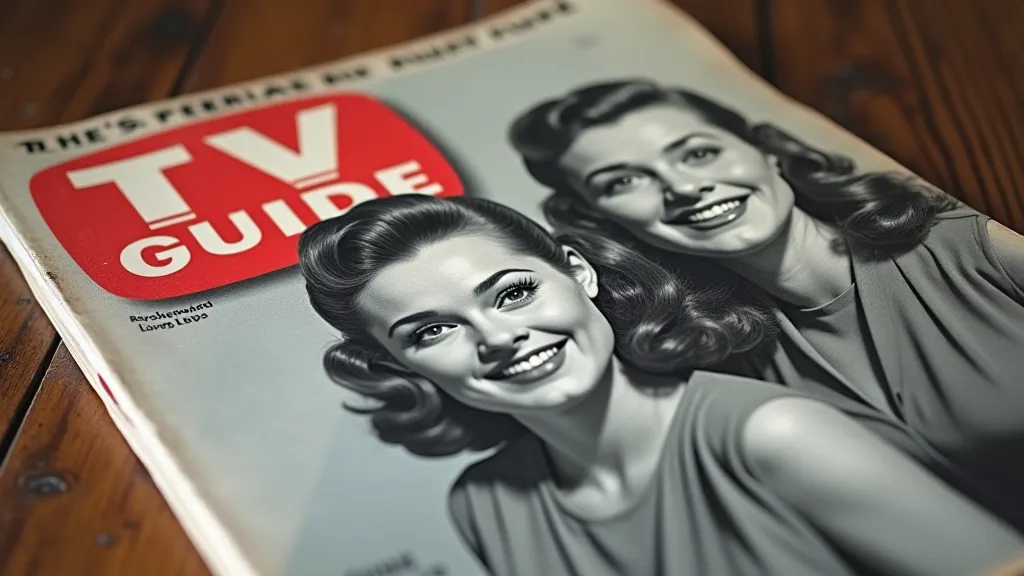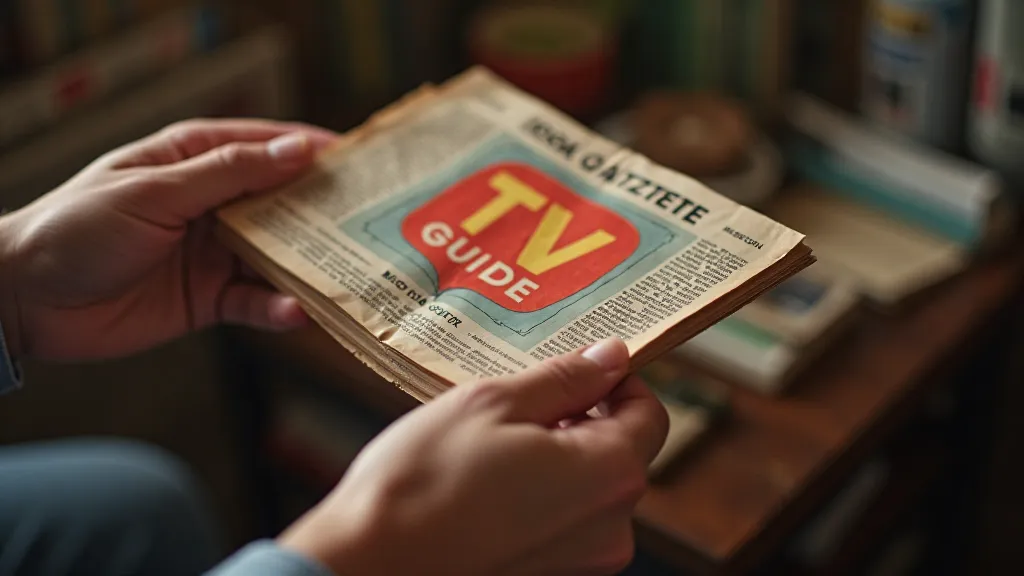Mirrors of Consumption: How Advertising in Vintage TV Guides Reflected American Dreams
The scent of aged paper, the slightly yellowed cover depicting a starlet in a fitted dress – holding a vintage TV Guide is more than just holding a relic of the past; it’s holding a portal. A portal to a time of post-war optimism, burgeoning consumerism, and the birth of modern American family entertainment. My own journey into collecting these iconic publications began not with a quest for rarity, but with a memory. My grandfather, a quiet man of routine, always had a TV Guide spread out on the kitchen table. It wasn't just a listing; it was a ritual, a connection to the wider world, and a silent testament to the dreams he held for his family.
Today, the internet provides instant access to streaming services and on-demand content. But for generations, the TV Guide was *the* guide, the compass navigating the burgeoning landscape of broadcast television. To truly appreciate the value of these vintage editions – and not just for their monetary worth – is to understand the subtle, and sometimes blatant, narratives woven within their advertisements. These weren’t just selling products; they were selling lifestyles, aspirations, and a particular vision of the American Dream.
The Rise of Television and the Birth of a Medium
The early years of television (the 1950s and early 1960s) were transformative. Broadcast television wasn’t just a new form of entertainment; it was a symbol of technological advancement and postwar prosperity. Families gathered around a single television set, a gleaming piece of furniture representing progress and modernity. The TV Guide, first published in 1953, quickly became an indispensable part of this experience. Think about the context: rationing was over, suburbia was blooming, and families were eager to embrace the future. Television reflected, and actively shaped, this environment. Programs like "I Love Lucy," "Leave it to Beaver," and "The Twilight Zone" didn’t just entertain; they provided templates for how to live, what to aspire to, and how to consume. Understanding the long-term impact of these early shows and the evolution of viewing habits is a fascinating area of study—a deep dive into the era’s cultural landscape reveals how the cartographer of dreams truly shaped national viewing habits.
Early TV Guides were different from what we know today. They were smaller, often just eight pages, and primarily focused on listings. The advertisements, however, were growing in sophistication, moving beyond simple product announcements to embrace storytelling and aspirational imagery. This was the beginning of “Madison Avenue” wielding its influence over the American household, and the TV Guide was a particularly receptive vessel.

Advertising as Aspirational Storytelling
Examine a 1960s TV Guide, and you're immediately struck by the sheer volume of advertising. But it's not just about *what* was being advertised; it's about *how*. Car advertisements weren't simply presenting features; they depicted families embarking on exciting road trips, symbolizing freedom and adventure. Food advertisements showed perfectly manicured lawns, impeccably dressed hosts, and lavish dinner parties, subtly implying that buying their product would elevate your own social standing. Laundry detergent ads showed gleaming white shirts – not just clean clothes, but a testament to a pristine and orderly home life.
The use of color in advertising escalated dramatically throughout the 1960s, further amplifying the emotional impact. Suddenly, breakfast wasn’t just about sustenance; it was about vibrant oranges, glistening bacon, and a family gathered around a picture-perfect kitchen. This was the era of the “Happy Homemaker,” and the TV Guide served as her constant companion, filled with subtle cues on how to achieve this ideal. It’s a fascinating glimpse into how manufacturers sought to shape societal expectations and leverage those desires for commercial gain.
Consider the portrayal of women in these ads. While often presented as gracious and nurturing housewives, they also embodied a sense of style and sophistication. They weren’t merely domestic figures; they were trendsetters, demonstrating that even the simplest act of choosing a brand of coffee could be a statement of personal taste. The details of their attire, the presentation of their homes, all contributed to the curated image of the ideal American family.
The Subtle Craft of Persuasion
The advertising in vintage TV Guides demonstrates a remarkable level of craftsmanship. Copywriters understood the power of subtlety, crafting narratives that resonated with the anxieties and aspirations of their target audience. They weren't just selling products; they were selling dreams. The quest for these valuable editions has driven a passionate collecting community, and for those looking to delve into the specifics of identifying rare finds, the curator’s codex provides a practical guide to identifying first editions and rare TV Guides.
The layout and design of these advertisements were also carefully considered. Images were strategically placed to draw the eye, and typography was used to create a specific mood. The overall effect was one of polished elegance and understated luxury. It’s a far cry from the often-aggressive and overwhelming advertising we see online today. There’s a certain charm and sophistication to the older approach, a sense of respect for the consumer’s intelligence.

Beyond the Listings: The Rarity and Value
For collectors, the value of vintage TV Guides extends beyond their advertising content. Certain editions are prized for their historical significance, their limited print runs, or their connection to iconic television moments. First editions, regional editions (often with unique advertising content), and those featuring popular programs like "The Ed Sullivan Show" command the highest prices. The pursuit of these treasures often leads to interesting narratives about the history of publishing and the evolution of marketing strategies.
Identifying a TV Guide’s rarity can be a fascinating pursuit in itself. Understanding the subscription history, the print run, and the regional distribution are all crucial factors. While a quick online search can provide a general pricing guide, the true value is often determined by condition, completeness, and provenance. A pristine copy of a 1969 Moon Landing edition, for example, would be worth significantly more than a well-worn copy from the same era. The factors influencing value are complex and change over time, further illustrating the dynamic nature of the collectibles market.
Restoration and Preservation
Preserving these fragile pieces of history requires careful attention. Acid-free sleeves are essential for protecting the pages from further deterioration. Storing the guides in a cool, dry environment away from direct sunlight is also crucial. Avoid excessive handling, and resist the urge to “clean” the pages, as this can damage the paper. The goal is to stabilize the existing condition, not to achieve a pristine appearance. The character and charm of a vintage TV Guide lie in its imperfections – the slight yellowing of the paper, the subtle wear and tear, the faint traces of a bygone era.
While restoration is possible, it should be undertaken by experienced professionals. Attempting DIY restoration can often do more harm than good. The value isn's just financial; it's also about maintaining the integrity of a tangible piece of history that offers insight into the culture of its time. For those eager to learn about the considerations that go into maximizing the value and safeguarding the future of these treasured artifacts, the price of nostalgia offers a collector’s perspective on the fluctuating market for vintage TV Guides.

A Window to the Past
Collecting vintage TV Guides is more than just a hobby; it's a journey into the heart of mid-century American culture. It’s a chance to reconnect with a time of optimism, aspiration, and a shared sense of community. By examining the advertising within these iconic publications, we gain a deeper understanding of the values, anxieties, and dreams that shaped a generation. And, perhaps most importantly, we gain a renewed appreciation for the power of storytelling, the artistry of persuasion, and the enduring legacy of a truly remarkable medium. The continued fascination with this era highlights the powerful role that media plays in shaping our collective memory and defining what it means to be American.





